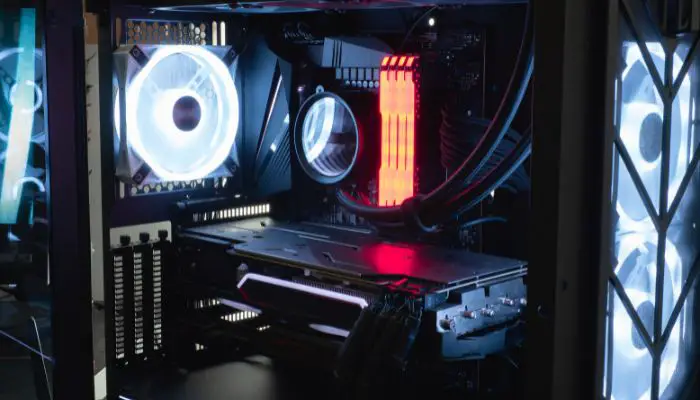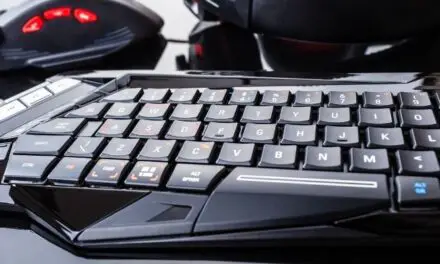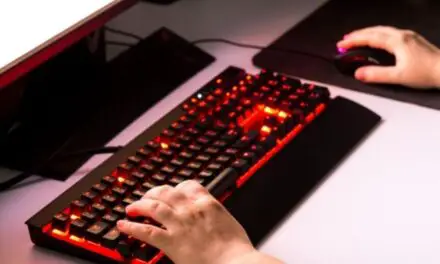The big game titles of today ask more than ever from our gaming PCs. Better 2D and 3D graphics rendering, texture mapping, and more allow our favorite games to be played at higher resolutions and faster frame rates.
It stands to reason that the computers that play these games would require a serious amount of power to operate but as technology advances, the components that make up our gaming PCs become more efficient.
So what’s the deal, do gaming PCs cost an arm and a leg to run?
Table of Contents
Are Gaming PCs Expensive To Run?

Gaming PCs can be expensive to run. Compared to a laptop, a gaming PC requires (on average) six times more power to run. According to experts, a gaming PC will typically average 1400 kWh on an annual basis. That’s also enough power to run 10 gaming consoles or three refrigerators annually.
The extent to which running a gaming PC will hit you in the pocket also depends on where you live. For example, Louisiana has one of the lowest electricity rates in the US which averages out at around 7 cents per kWh.
Compare that to living in Hawaii where your average kWh rate would be around 30.5 cents. That’s over 4 times more expensive.
But to know what you’re really paying, it’s best to measure it yourself.
To accurately measure the usage from your gaming PC and peripherals, plug the extension lead containing all the plugs for your PC setup into a power meter and plug that into the mains outlet. The power meter will then be able to measure your cost per kWh and current wattage. You should then be able to display your accumulated energy usage as kilowatt hours (1,000 watts of energy sustained for one hour).
You can then use your gaming PC as you normally would for a day and the meter will tell you your usage time, how many kilowatt hours you have consumed, and the cost.
So if you used your gaming PC for 5 or 6 hours and the cost came out at 10 cents, you could just multiply that by 30 or 365 to get your monthly or yearly average running costs.
All of the components in a gaming computer can be broken down into their individual power consumption levels. Of all of them, the GPU is by far the most power-hungry, with the CPU coming in as a distant second. The Power Supply Unit isn’t an internal component of the computer but it draws more power than even the GPU.
- Optical Drive: 15 to 30 Watts
- RAM: 2 to 5 Watts
- HDD: 1 to 9 Watts
- SDD: .5 to 3 Watts
- Cooling Systems: .5 to 3 Watts
- CPU: 50 to 150 Watts
- GPU: 25 to 350 Watts
- Power Supply Unit: 130 to 600 Watts
- Motherboard: 25 to 100 Watts
As your gaming PC gets older and the games you are running on it become more advanced, it will steadily use or consume more and more power.
Your monitor is considered to be a part of the gaming PC when calculating power consumption and it chews up its fair share as well.
How Much Does It Cost On Average To Game On PC?
A gaming PC will generally consume about 250 to 400 Watts per hour and the average cost for electricity in the United States is 10 cents per kilowatt. It could take a gaming PC anywhere between 2.5 and 4 hours to cost you $0.10.
A really high-end gaming PC that’s running a resource-intense game is capable of pushing the envelope to 600W per hour, so it would take 5 hours to reach a cost of $0.30. Talking about it like that, it doesn’t seem like it costs that much.
But it does add up over time. If you only run your gaming PC for 5 hours per day, that would account for a total of $109 at the end of the year, assuming that you are using enough power to cost yourself $0.30 every five hours.
How To Make Your Gaming PC More Energy Efficient
Fortunately, there are ways to tone down your power consumption, if it’s making as much of a difference in your power bill. In the above scenario, the power consumption would cost you an additional $9.08 per month.
If you are using your gaming PC for a living, you will probably end up burning more electricity than in the above example. There are a few things, in terms of components and settings changes that you can do to bring that number down some.
- Adjust the power-saving options on your PC’s settings
- Use sleep mode if you are not downloading each night
- Unplug external devices when you are done playing
- Keep your background programs closed when not in use
- Purchase energy-efficient components
- Switch from HDD to SSD
Change Windows Power and Sleep Settings
The power savings options are always going to be a source of contention amongst gamers, mainly because most of the features directly interfere with either gaming or downloading other games, DLC, or related content, which gamers will often do long after they’ve gone to bed.
Hibernate mode is better than sleep mode if you aren’t going to have anything running throughout the night. Unlike sleep mode, hibernate saves data to regular storage and not RAM, so it’s almost as if the PC is completely turned off.
When sleep mode is in use, it typically shuts down power to the display, some of your peripherals, and your RAM. Hibernate mode shuts down just about everything, saving your current state to the HDD or SSD.
But if there is no reason for your PC to be running, just shut it down. If your system features lots of fast RAM and an SSD, your PC will power on from off just as fast as it will wake up from sleep or hibernation.
Related Article: Top 23 Reasons Why You Should Buy A Gaming PC Instead Of A Console
Upgrade from an HDD to an SSD
There are a lot more reasons for doing this than just a matter of power consumption. A Solid State Drive is far more power efficient and better than a traditional Hard Drive.
- SSDs are faster
- SSDs are much more resilient
- They run quieter
- SSD draws less power
The only advantage that you get with an HDD is that you won’t pay nearly as much money for one. SSDs are more expensive because the next best thing usually is. However, it’s not like Solid State Drives are brand spanking new anymore and the prices on them are steadily trickling down.
They are far more resilient than HDDs are and you can expect an SSD to last a lot longer, without the common functionality problems that an HDD throws your way every now and then.
An SSD is also far quieter than an HDD, so you don’t get that irritating sound that an HDD emits when it cycles up.
The main point, however, is that an SSD runs on half the power of an HDD. Typically 5 Watts to an HDD’s 10 Watts. It’s a minor difference, but these things add up.
Use a Good, Quality Power Supply
An efficient power supply is not going to be a cheap power supply and the amount of power that you need is generally determined by what setup you have with your gaming PC. People that are new to gaming PCs and trying to put together their own build will often fudge when it comes to the power supply.
When you are looking for something that is energy efficient, it still has to meet the demands of your components, especially your GPU and your CPU. What you want to look for is a power supply that is more energy efficient at higher loads.
The words that you are looking for are 80 PLUS Gold, 80 PLUS Titanium, or 80 PLUS Platinum. These power supplies are far more efficient at lighter loads than older or cheaper power supplies.
Bronze and Silver are okay, but if you are really looking to save power and get more efficiency at lower loads, you need to stick with gold, platinum, and titanium.
Compatibility is also an issue, so that’s something you should pay attention to while browsing through power supplies.
Unplug External Devices When Not In Use
External devices that may continue to use power when plugged in are things like speakers, extra monitors, printers, or external hard drives. You should always unplug them when the computer is not in use because they often continue to draw power, even when your computer is asleep.
If you like to have docking stations hooked up to your computer, you should consider unplugging them as well. It may seem like a pain to unplug or physically turn everything off but, in a lot of instances, these things continue to draw power.
The only way to ensure that they aren’t drawing power is to physically separate them from a power source.
Use an Energy Efficient Monitor
Monitors are crucial to lowering your energy consumption rate. That’s because they are more power-hungry than your CPU, which is pretty hungry all by itself. In fact, it’s about 25% higher than the CPU in terms of energy use while it’s on.
It’s easy to simply look for the Energy Star compliance symbol on the box and throw it in the trolley or in your digital cart but there is a degree or two of separation, even among Energy Star compliant monitors.
When it comes to the best energy efficiency, you will usually find that in an LCD monitor. According to energy.gov, monitors, like TVs use numbers to indicate their energy efficiency, with the lower numbers meaning that they are more efficient than the higher numbers.
The Energy Star compliance sticker will usually be located close to the efficiency number on the monitor when you purchase it. The 30s are best in efficiency, while the 40s are medium-range, and the 50s are getting pretty inefficient.
Some of the best available monitors that are the most energy efficient are going to have the number 33 somewhere on the box or the back of the monitor. However, you should also realize that the more efficient it is, the more likely it is to make sacrifices in the technical prowess of the display.
You can make a happy compromise by finding something squarely in the number 44 range.
Use Wake On LAN For Remote Access
Wake on LAN is the solution to the issue with hibernating and sleeping that we referred to above. The problem is, that updates and certain downloads are important and we like to have this process automated. You don’t want to not stay on top of anti-virus updates, security patches, and other administrative software updates.
WoL (Wake on LAN) allows your computer to be turned on remotely, whether it’s from you or due to a certain activity, such as an automatic update. It’s especially useful if you have a game server program or VNC, TeamViewer, or a file server.
Most ethernet or wireless cards support the WoL option, so you shouldn’t have any difficulty there. The first thing to do is access your BIOS. Since there are so many ways to do that, you will have to get into your BIOS in whatever way you can on your particular PC.
- Go to Power Management or Advanced Options
- You may have to go in and out of several menus to find it
- Once you find it, ensure that it’s enabled
- Go to your home screen in Windows
- Open up the Start Menu and search for “Device Manager”
- Scroll down to “Wake on Magic Packet”
- Enable it
- Go to the Power Management Tab
- Make sure that “Allow this device to wake the computer” is set as enabled for “Magic Packet”
The rest is up to you as far as figuring out what the WoL requests are going to be and how often they come through.
If you’re having difficulty getting WoL to work reliably when you’re away, try plugging your PC into a smart socket and setting the BIOS to wake on AC power restore. You could then power up your PC by cycling the power remotely with Alexa or Google Home.
All Things Considered
As you can see, there are a lot of roads that you can explore to find ways to make your PC more energy efficient. It’s not a matter of just any one thing.
If you’re building a PC, especially for the first time, it will take a bit of homework on your part. Ultimately, it will save you some energy and potentially a little bit of money in the end.



